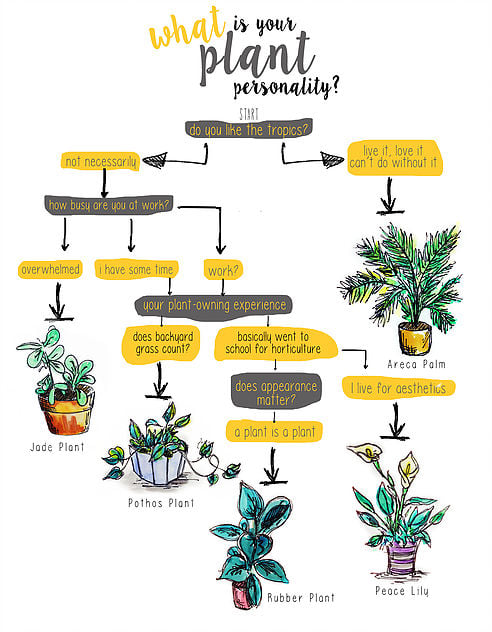The first thing you see when you stroll into the dentist’s office is not your doctor’s diploma plastered on the wall, or the medical certification plated on an exorbitantly priced piece of wood. What you really notice is the cactus that the receptionist has strategically placed right at the edge of their desk. Then you look around a little more, and realize that you are sharing the space with potted philodendrons, ferns, and maybe some lilies if you’re lucky. Whether you have thought about it or not, the plants’ presence makes you feel calm and collected.
That's because plants have the magical ability to relieve physical and psychological stress, while improving air quality and stimulating work productivity. During the winter, when snow and cold weather replace natural green leaves, you have no choice but to turn to plan B: indoor plants. That doesn’t mean that you should immediately start hoarding potted plants and start a nursery in your backyard – although it’s not a bad life goal. It just means that seeing green once in a while can be good for our visual health in an age where staring at computer screens 24/7 is the norm.
Green is good.
In a study completed on stress-reducing environments, faculty at the University of Twente in the Netherlands confirmed that participants “exposed to hospital rooms with indoor plants reported less stress than those in the control condition.” [1] Patients with visible plants in their room were recorded to have less stress and anxiety. In addition to psychological relaxation, the color green also relieves stress on your eyes. Our eyes perceive color using tiny sensors called cones which are sensitive to red, green or blue light. In general, our eyes tend to be more sensitive to wavelengths at about 550 nm[2] which translates to green. Simply put, our eyes use less energy to perceive green, and it’s not because we’re jealous.
We learned in elementary science class that plants can convert carbon dioxide into oxygen through photosynthesis. Our green friends help clean the air that we breathe in a stuffy office that otherwise torment our lungs and hinder productivity. By having a plant on the corner of your desk, you are able to engage with your surroundings, keeping you happy while maintaining mental activity. Take the time to look away from your computer screen every once in a while, even if it means gazing at the dollar-store green plant you see near you. Green is still good.
So get on that trip to Home Depot and pick up a plant or two for your office desk!
Got our eye on these #guiltless greens. With these, you’ll never have to feel sorry about refusing the weekend treks to work just to water your plants!
Take the quiz to find out your plant personality!

Pothos:
Why you need it: It’s an indoor plant that is great with first time plant owners. Not only so, Pothos plants have an air-purifying quality that can absorb toxins in your surroundings. You never know if your office carpet was soaked in acetone before it came to be under your feet. A little trim every month off the mile-long stem trails can help keep your plant looking healthy and young!
Jade Plants:
Why you need it: One of the most ‘pinterest’ worthy potted plants for your desk. Easy to care for, looks fabulous, and best of all, it lives forever – only a slight exaggeration. Jade plants do not need constant watering; they actually would rather be somewhat dry. Keep it in bright light for the best results!
Areca Palm:
Why you need it: The winter can be pretty drab sometimes. Areca Palms only need to be watered every other week and actually enjoy staying dryer than other plants. This indoor house palm makes your tropical dreams come true, even if it’s hypothermic outside. It matches with any type of office space and lifts your spirits!
Peace Lily:
Why you need it: You’ve seen it in almost every home. Its beauty is in its simplicity and elegance. The Peace Lily, if cared for correctly, will produce a beautiful bloom that is protected by a white hood. It thrives in bright, filtered light, but will survive in low, interior light. Water it once a day and you could have a sophisticated plant sitting at your desk that looks like you spent hours caring for it. Let people think that, if you want.
Rubber Plant:
Why you need it: One of the easiest indoor plants to grow, the Rubber Tree gives a pop of green in any setting. The dark green leaves have a shiny sheen that will keep you stay visually engaged 24/7. In the wild, this tree can grow up to 100 feet. However, if you want to keep your plant tamed in the office, all you have to do is to trim any long stems when you see them. Allow the surface of the soil to dry out in between watering to get the best results and you’re all set!
Sources:
[1] Dijkstra, K., M.E. Pieterse, and A. Pruyn. "Stress-reducing Effects of Indoor Plants in the Built Healthcare Environment: The Mediating Role of Perceived Attractiveness." Preventive Medicine 47.3 (2008): 279-83. Elsevier. Web.
[2] Bye, Louise, Neil Modi, and Miles Stanford. Basic Sciences for Ophthalmology. N.p.: Oxford UP, 2013. Print.


